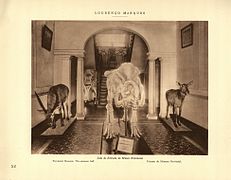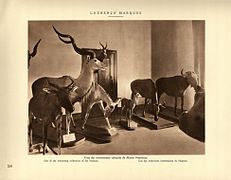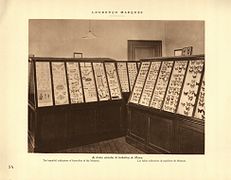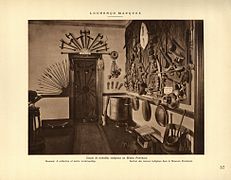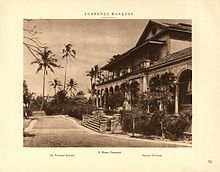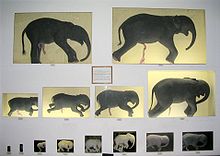Museu de História Natural de Moçambique

The Museu de História Natural de Moçambique , Portuguese for Museum of Natural History of Mozambique , is a natural history museum in the Mozambican capital Maputo . It is located in the Polana district on Praça Travessia do Zambeze . The museum opened as Museu Provincial in 1913 , moved to the current building in 1932/33 and was named after a Portuguese governor, Museu Dr. Álvaro de Castro .
The museum has had its current name since Mozambique became independent from the colonial power of Portugal in 1975. It is the only museum of its kind in the country.
history
Established as Museu Provincial
The museum was established on June 6, 1913 as the Museu Provincial (Provincial Museum) on the initiative of Capitão Alberto Graça, a Portuguese teacher at Escola 5 de Outubro , in the school building of Escola 5 de Outubro.
Just three years later, the then governor-general of the colony of Mozambique, Álvaro de Castro , recognized the importance of such a museum for the colony and ordered a move from the school building to the Vila Jóia , a villa in the then botanical city park Jardim Vasco da Gama (today Jardim Tunduru ) the colonial capital. However, the museum remained under the supervision of the school management, in particular teachers of the natural sciences were supposed to impart practical teaching content to pupils there.
- Details of the museum's exhibition in 1929
Renaming and move to a new building
In 1932 the museum moved again, to a building originally intended for a primary school on what was then Praça das Descobertas (now Praça Travessia do Zambeze ), where it is still located today. With the move, the museum also received a new name, henceforth it was called Museu Dr. in honor of the former Governor General. Álvaro de Castro .
The building had been built by the city council of Lourenço Marques. The two-storey building on a trapezoidal floor plan was given a facade in the classic-looking and, due to the historicizing zeitgeist, tradition- oriented neo- Manueline style. In 1940 the city administration launched a competition for an extension of the museum, which, however, did not take place despite a design by the Portuguese architect João José Tinoco .
From 1957, the museum was no longer under the supervision of the school, which was now called Liceu Salazar and had been located next to the museum a few years earlier. Instead, it belonged to the colonial authority for public education for two years, before moving from 1959 to the direction of the Institute for Scientific Research in Mozambique ( Instituto de Investigação Cientifica de Moçambique ).
Persistence after Mozambique gained independence
Regardless of Mozambique's independence, the museum remained true to its theme and continued to serve as a natural history museum for the independent country. However, the government ordered the museum to be renamed - as did many other streets and public facilities. Since then, the museum has been called Museu de História Natural de Moçambique (Natural History Museum of Mozambique) and is under the supervision of the Eduardo Mondlane University of Maputo .
The main aim of the museum is to explain Mozambique's natural history and ethnographic past. In particular the animal world of the country is represented with numerous animal preparations. A special feature is the collection of elephant fetuses in various stages of development, from the first to the 22nd month of birth.
The museum building belongs to the well-preserved architecture of the Portuguese colonial era. Since 2011 the building has been in the preselection for a list of monuments for the city of Maputo. It is listed under number 31371 in the Portuguese monument database Sistema de Informação para o Património Arquitectónico , which also includes works by former Portuguese colonies.
Web links
Individual evidence
- ↑ Communication No. 1095-A in the Kolonialblatt von Mozambique
- ↑ a b c d Vanda Mahumane: 100 Anos do Museu de História Natural. In: MMO (Mozambique Media Online). August 2, 2013, accessed December 23, 2016 (Portuguese).
- ↑ a b Tiagou Lourenço: Museu de História Natural / Museu Álvaro de Castro / Museu Provincial. In: Sistema de Informação para o Património Arquitectónico (SIPA). 2011, accessed December 23, 2016 (Portuguese).
- ↑ Decree No. 41472 in the Kolonialblatt von Mozambique
- ↑ Museu de História Natural. Universidade Eduardo Mondlane, accessed December 23, 2016 (Portuguese).
Coordinates: 25 ° 58 ′ 38.3 ″ S , 32 ° 35 ′ 12.8 ″ E
